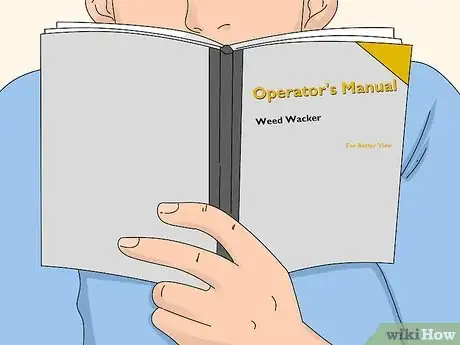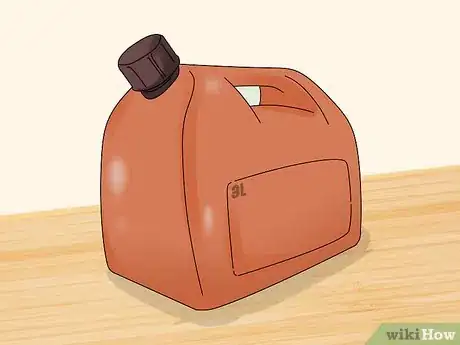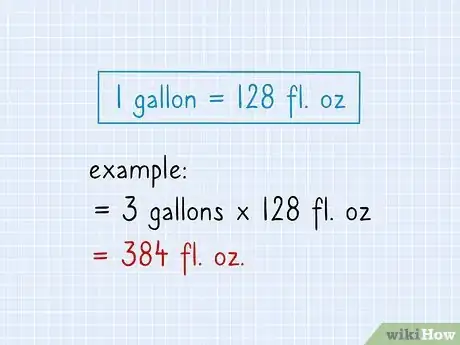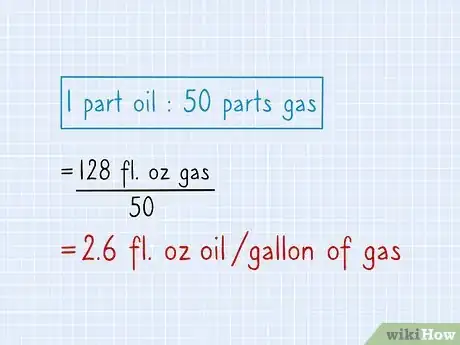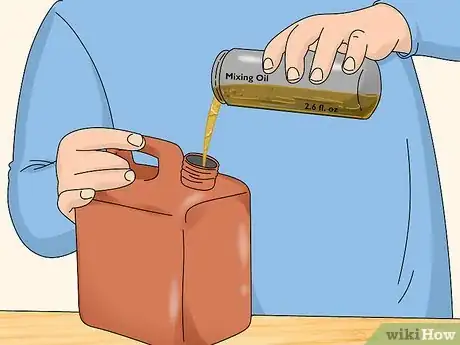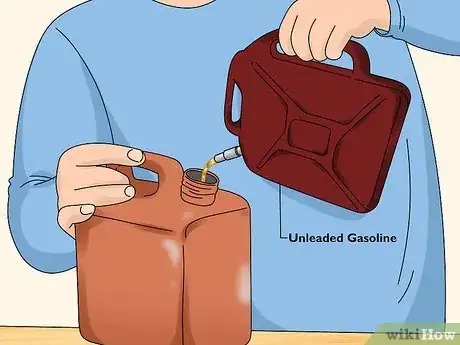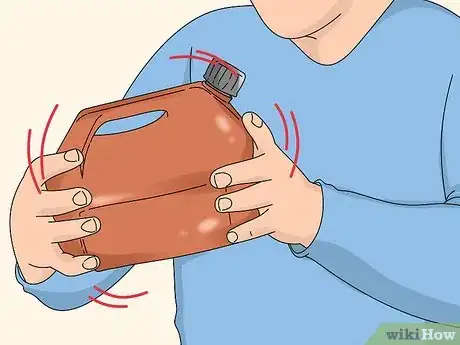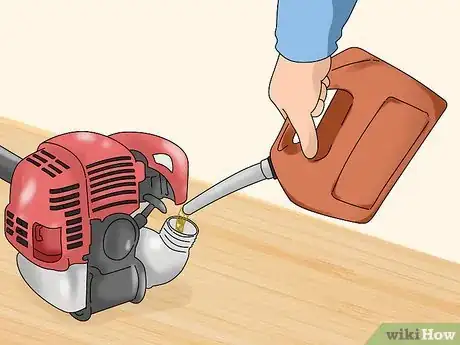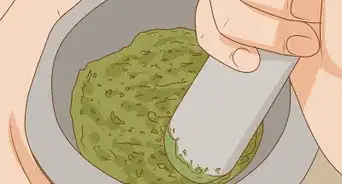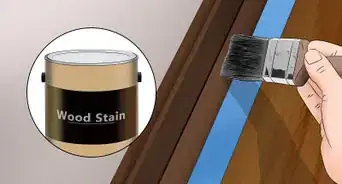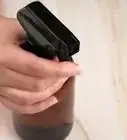This article was co-authored by Grant Wallace. Grant Wallace is a Landscaper and Owner of Grantlanta Lawn in Atlanta, Georgia. With over seven years of experience, he specializes in lawn maintenance and landscape installation. In 2012, he earned his BA from the University of West Georgia. Grant has been profiled in Shoutout Atlanta, Canvas Rebel, and Voyage ATL.
This article has been viewed 19,609 times.
Weed wackers are a handy tool for all homeowners to have, so naturally you want to keep yours in good working order. Like other small-engine power tools, weed wackers require a mixture of engine oil and gasoline to run properly. Making the mixture is simple once you know the correct proportion. After that, just pour in the right amounts of oil and gas into a jerry can, mix it up, then start your machine.
Steps
Finding the Correct Measurements and Materials
-
1Check your user manual for the correct ratio for your week wacker. This ratio is how much oil you need to mix into the gas for ideal performance. A 50:1 ratio, for example, means that you need 50 parts of gas for 1 part of oil. Different weed wacker models might have different suggested ratios, so always confirm the recommended ratio to keep your engine in good working order.[1]
- The most common mixtures for small engines are 32:1, 40:1, 50:1, or 100:1. Currently, the most common mixtures are 50:1 and 40:1.
- If you don’t have the user manual, try searching online for your weed wacker model and recommended oil mixture, or contact the manufacturer.
- When you learn the correct oil mixture, write it down somewhere or on the side of the machine so you don’t forget.
-
2Get a jerry can that holds 1 US gal (3.8 L) of gasoline. A jerry can is a container designed to hold gasoline. Since weed wackers have small gas tanks, a 1 US gal (3.8 L) can should be plenty.[2]
- 1 US gal (3.8 L) is also a good amount because in the US, mixing oil usually comes in small bottles measured to a 50:1 mixture for a gallon of gas. This way, you can just pour in the whole bottle, unless you're using a different ratio.
- Only mix gas in a container meant to hold gasoline.
- If you’re using an old container, clean off the area around the lid so no dirt or grime gets into your gasoline.
Advertisement -
3Convert gallons to fluid ounces to make the math easier. There are 128 fl. oz. in a gallon, so that means there are 128 fl. oz. in your jerry can. Converting to ounces makes the measurement much easier because oil cans come in ounces rather than gallons.[3]
- If you have a jerry can that holds more than 1 gallon (3.8 L), just multiply the number of gallons by 128. A 3-gallon can, for instance, has 384 fl. oz.
-
4Divide 128 by 50 for a perfect 50:1 mixture. If you need 1 part of oil for every 50 parts of gas, then divide the total amount of gasoline by 50.The result is 2.6, meaning that you need 2.6 fl. oz. of oil for a gallon of gas.[4]
- This also works with other mixtures, like 40:1. Just divide by 40 instead of 50. 128 fl. oz. is 3.2 fl. oz. if you divide it by 40. This means you need 3.2 fl. oz. of oil per gallon of gas for a 40:1 mixture.
- Use the same calculation for milliliters. If you have a 5-liter can, this is 5,000 ml. Divide 5,000 by 50 to get 100 ml of oil.
Mixing the Gas
-
1Pour 2.6 fl. oz. of oil into the can first. Get a bottle of mixing oil from the hardware store or auto parts store. Shake the oil first. Then pour the oil into a measuring cup to make sure you use the right amount. Pour the oil directly into the can.[5]
- This calculation is for 1 gallon (3.8 L) of gas at a 50:1 mixture, so adjust that if you use a different amount of gas or different mixture.
- In the US, mixing oil usually comes in small bottles measured to a 50:1 mixture for a gallon of gas. In this case, pour a whole bottle of oil in for every gallon of the mixture for easy measuring.
- Some bottles come in different concentrations as well. If you need a 40:1 mixture, look for a 40:1 oil bottle. This makes measuring much easier.
-
2Add mid-level unleaded gasoline into a jerry can up to the fill line. Medium gasoline, with an octane rating of 89, is the minimum type for keeping your weed wacker in good working order. Pour the gas directly into the can up to the fill line so your proportions are correct.[6]
- Don’t overfill the can. If you go over the fill line, your oil concentration will be too low.
- You could also use premium-level gasoline to protect your engine better. Don’t go below an 89-octane rating, though, or you could damage the engine over time.
-
3Shake the can gently to mix the oil and gas. Seal the container first. Then pick it up and swish it around so the oil and gas mix well together.[7]
- Shaking in a circular motion is best. Shaking up and down could spill the gas out.
-
4Fill your weed wacker with the gas mixture. Once your gas is all mixed up, pour it directly into the weed wacker gas tank. Start the machine up and clean out your yard.[8]
Expert Q&A
-
QuestionCan you use ethanol free gas in a Weed Eater?
 Grant WallaceGrant Wallace is a Landscaper and Owner of Grantlanta Lawn in Atlanta, Georgia. With over seven years of experience, he specializes in lawn maintenance and landscape installation. In 2012, he earned his BA from the University of West Georgia. Grant has been profiled in Shoutout Atlanta, Canvas Rebel, and Voyage ATL.
Grant WallaceGrant Wallace is a Landscaper and Owner of Grantlanta Lawn in Atlanta, Georgia. With over seven years of experience, he specializes in lawn maintenance and landscape installation. In 2012, he earned his BA from the University of West Georgia. Grant has been profiled in Shoutout Atlanta, Canvas Rebel, and Voyage ATL.
Landscaper For sure! Although it is a bit more expensive, it's a really great option!
For sure! Although it is a bit more expensive, it's a really great option!
Things You’ll Need
- Jerry can
- Mixing oil
- Medium-octane gasoline
Warnings
- Never mix or store gasoline in a container that wasn’t designed for it. This is a fire hazard and the containers could also leak.⧼thumbs_response⧽
References
- ↑ https://www.thedailygardener.com/weed-eater-oil-to-gas-ratio
- ↑ https://youtu.be/VKyeYt2og2I?t=90
- ↑ https://www.thedailygardener.com/weed-eater-oil-to-gas-ratio
- ↑ https://www.thedailygardener.com/weed-eater-oil-to-gas-ratio
- ↑ https://youtu.be/VKyeYt2og2I?t=401
- ↑ https://www.thedailygardener.com/weed-eater-oil-to-gas-ratio
- ↑ https://www.thedailygardener.com/weed-eater-oil-to-gas-ratio
- ↑ https://www.thedailygardener.com/weed-eater-oil-to-gas-ratio
- ↑ https://www.bobvila.com/articles/how-long-does-gasoline-last/
